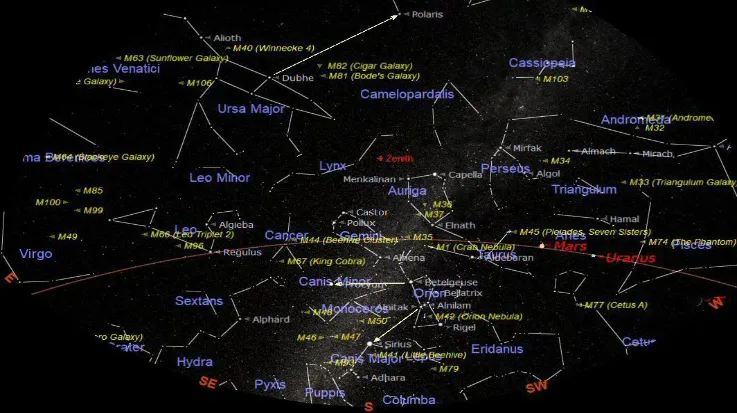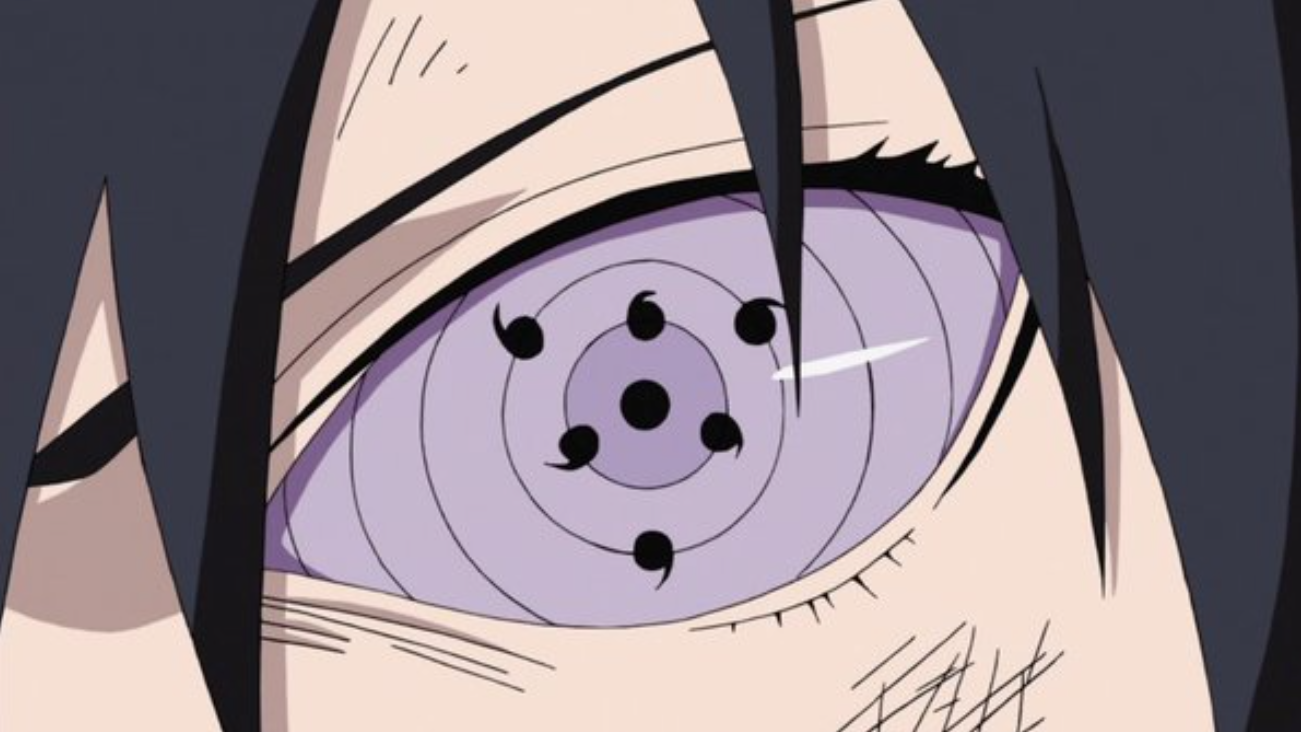Night sky, May 2021- What you can see this month with astro map
PostedAt: Fri, May 7, 2021 12:14 PM
Find out what's up in your night sky during May 2021 and how to see it in this stargazing guide.
A clear night sky offers an ever-changing display of fascinating objects to see — stars, constellations, and bright planets, often the moon, and sometimes special events like meteor showers. Observing the night sky can be done with no special equipment, although a sky map can be very useful. Binoculars or a good beginner telescope will enhance some experiences and bring some otherwise invisible objects into view. You can also use astronomy apps and software to make your observing easier, and use our Satellite Tracker page powered by N2YO.com to find out when to see the International Space Station and other satellites. Below, find out what's up in the night sky tonight (Planets Visible Now, Moon Phases, Observing Highlights This Month) plus other resources (Skywatching Terms, Night Sky Observing Tips and Further Reading).

The night sky is more than just the moon and stars, if you know when and where to look.
(Image credit: Karl Tate/SPACE.com)
Night Sky Guides:
- When, where and how to see the planets in the 2021 night sky
- The top skywatching events to look for in 2021
- Best night sky events of May 2021 (Stargazing Maps)
- Space calendar 2021: Rocket launches, sky events, missions & more
Calendar of Observing Highlights
Monday, May 3 — Third quarter moon (1950 GMT)

(Image credit: Starry Night)
The moon will officially reach its third quarter phase at 3:50 p.m. EDT (1950 GMT) on Monday, May 3. At third quarter our natural satellite always rises in the middle of the night and remains visible in the southern sky all morning. The moon will appear half-illuminated, on its western side — toward the predawn sun. Third quarter moons are positioned ahead of the Earth in our trip around the sun. About 3.5 hours later, Earth will occupy that same location in space. The ensuing week of moonless evening skies will be ideal for observing deep sky targets.
Tuesday, May 4 — Moon between Jupiter and Saturn (predawn)

(Image credit: Starry Night)
When the third quarter moon rises over the southeastern horizon at about 3 a.m. local time on Tuesday, May 4, it will be positioned below and between bright Jupiter on the moon's left (or celestial northeast), and dimmer Saturn to the moon's upper right (or celestial northwest). The trio will make a lovely wide-field photograph when composed with some interesting landscape scenery.
Wednesday, May 5 — May is the month of Mercury (after sunset)

(Image credit: Starry Night)
After sunset throughout the month of May, 2021 Mercury will be easily visible by Northern Hemisphere observers while it travels on the high side of a nearly vertical evening ecliptic plane. The speedy planet will climb away from the sun until mid-month, when it will be at peak visibility. In the second half of the month Mercury will descend sunward, passing much brighter and slower Venus near month-end. As the sky grows darker each night, look for Mercury low in the west-northwest as a white point of light shining some distance above Venus. Since the planet will be traversing the space between us and the sun, telescope views of Mercury in May will show that its disk is growing larger while waning in illuminated phase (inset).
Thursday, May 6 — Eta Aquarid meteor shower peaks (predawn)

(Image credit: Starry Night)
The annual Eta Aquarid meteor shower is produced by particles of material left behind by repeated passages of Halley's Comet. The shower, which runs from April 19 to May 28, will peak in intensity before dawn on Thursday, May 6. Aquarids meteors will appear to be travelling away from a radiant point in Aquarius. That spot will lie near the southeastern horizon, not far from Jupiter. The southerly radiant makes this shower better for observers at low latitudes. On the peak night, watch for up to a few dozen meteors per hour, including some fireballs. A 25%-illuminated, waning crescent moon in the sky on the peak morning will reduce the number of meteors seen.
Friday, May 7 — The Virgo Cluster of galaxies (all night)

(Image credit: Starry Night)
The Virgo Cluster contains as many as 2,000 galaxies — dozens of which are visible with amateur telescopes under dark sky conditions during spring evenings. The cluster ps nearly a fist's diameter (8 degrees) of sky on the border between Virgo and Coma Berenices. The brightest member is the elliptical galaxy Messier 49, which is located a generous palm's width to the lower right (or 8.5 degrees to the celestial southwest) of the bright star Vindemiatrix (Epsilon Virginis). Using low magnification, aim your telescope mid-way between Vindemiatrix and the bright star Denebola (Beta Leonis). That region contains a large number of bright galaxies, including the Messier objects M84 and M86 through M91. Markarian's Chain is a spectacular, curved line of galaxies pning 1.5 degrees. It arcs to the upper left (celestial north) from M84.
Saturday, May 8 — Whirlpool and Pinwheel Galaxies (all night)

(Image credit: Starry Night)
On evenings during May, the Big Dipper is positioned nearly overhead in the northeastern sky. Under dark sky conditions two impressive galaxies can be seen in binoculars (red circle) and backyard telescopes. You can use the bright star Alkaid at the tip of the dipper's handle to locate them. The Pinwheel Galaxy, or Messier 101, is a spectacular face-on spiral galaxy positioned a palm's width to the lower left (or 5.5 degrees to celestial north) of Alkaid, forming an equilateral triangle with Mizar, the double star at the bend of the handle. This relatively close galaxy (21 million light-years away) is nearly as large as the full moon in the sky (inset). Since the galaxy's light is spread over such a large area, its overall brightness is low. Aim your binoculars several finger's widths above Alkaid to discover the iconic Whirlpool Galaxy, aka Messier 51. This spiral galaxy's angular size is smaller, but it will look somewhat brighter in your binoculars and telescope (inset). A secondary galaxy core designated NGC5195 is linked to Messier 51 by a stream of stars.
Tuesday, May 11 — New moon (1900 GMT)

(Image credit: Starry Night)
The moon will officially reach its new phase on Tuesday, May 11 at 3 p.m. EDT (1900 GMT). While new, the moon is travelling between Earth and the sun. Since sunlight can only reach the far side of the moon, and the moon is in the same region of the sky as the sun, the moon becomes completely hidden from view from anywhere on Earth for about a day. After the new moon phase Earth's celestial night-light will return to shine in the western evening sky.
Wednesday, May 12 — Crescent moon kisses Venus (after sunset)

(Image credit: Starry Night)
Low in the west-northwestern sky after sunset on Wednesday, May 12, the young crescent moon will be positioned a finger's width to the lower left (or 1 degree to the celestial south) of Venus. The very bright planet will be easier to find first as the sky darkens after about 8 p.m. local time. Be sure that the sun has completely set before using binoculars or a telescope (red circle) to view the duo. Observers in much of New Zealand, Eastern Polynesia, and Easter Island can see the moon occult Venus in the mid-day sky.
Thursday, May 13 — Crescent moon near Mercury (after sunset)

(Image credit: Starry Night)
A day after passing Venus, the crescent moon will climb to sit several finger widths to the left (or 3 degrees to the celestial southeast) of Mercury in the west-northwestern sky of Thursday, May 13. The pair will set at about 10 p.m. local time — well after sunset, allowing them to shine in a darkened sky. The moon and the planet will fit together in the field of view of binoculars (red circle). Bright Venus will shine below them.
Saturday, May 15 — Crescent moon and Mars (evening)

(Image credit: Starry Night)
In the western sky after dusk on Saturday, May 15, the pretty, waxing crescent moon will shine several finger widths to the lower right (or 2 degrees to the celestial northwest) of the reddish planet Mars. The duo will appear together in binoculars (red circle). The moon's orbital motion will carry it closer to Mars by the time they set together shortly before midnight local time.
Sunday, May 16 — Moon occults bright star Kappa Geminorum (early evening)

(Image credit: Starry Night)
On Sunday evening, May 16, observers in the eastern continental U.S. and Canada can watch the waxing gibbous moon occult the medium-bright star Kappa Geminorum (or κ Gem). The dark leading edge of the moon will cover the star first, causing its point of light to wink out. The star will reappear from behind the bright eastern limb of the moon some time later. Ingress and egress times vary by latitude — so use Starry Night or another astronomy app to look up the times where you live. In New York City, Kappa Geminorum will disappear at 9:37 p.m. EDT and re-appear at 10:39 p.m. EDT. Wherever you are observing from, start watching a few minutes before the appointed times. The event will be visible in binoculars and backyard telescopes — but remember that a telescope (red circle) will likely invert and/or mirror the scene shown here.
Sunday, May 16 — Mercury at greatest eastern elongation (after sunset)

(Image credit: Starry Night)
In the west-northwestern sky on the evening of Sunday, May 16, Mercury (orbit shown in red) will be hours from its widest separation, 22 degrees east of the sun. With Mercury positioned above (north of) the evening ecliptic (green line), this appearance of the planet will offer excellent views for Northern Hemisphere observers, but not so for observers in the Southern Hemisphere. The optimal viewing period at mid-northern latitudes will be 8:30 p.m. to 9:30 p.m. local time. Viewed in a telescope (inset) the planet will exhibit a waning, half-illuminated phase.
Tuesday, May 18 — "Lunar X" in twilight (peaks at 9 p.m. EDT)

(Image credit: Starry Night)
Several times a year, for a few hours near its first quarter phase, a feature on the moon called the "Lunar X" becomes visible in strong binoculars and backyard telescopes. When the rims of the craters Purbach, la Caille, and Blanchinus are illuminated from a particular angle of sunlight, they form a small, bright X-shape. The Lunar X is located on the terminator, about one third of the way up from the southern pole of the Moon (at 2 degrees east, 24 degrees south). The "X" is predicted to peak in intensity at around 9 p.m. EDT on Tuesday, May 18. That will be during waning daylight for observers in the eastern Americas — but you can observe the moon in a telescope during daytime, as long as you take care to avoid the sun. The Lunar X will be visible anywhere on Earth where the moon is shining, especially in a dark sky, between 2300 GMT on May 18 and 0300 GMT on May 19.
Wednesday, May 19 — First quarter moon (1912 GMT)

(Image credit: Starry Night)
When the moon completes the first quarter of its orbit around Earth at 3:12 p.m. EDT (1912 GMT) on Wednesday, May 19, the relative positions of the Earth, sun and moon will cause us to see it half-illuminated — on its eastern side. At first quarter, the moon always rises around noon and sets around midnight, so it is also visible in the afternoon daytime sky. The evenings surrounding first quarter are the best for seeing the lunar terrain when it is dramatically lit by low-angle sunlight.
Sunday, May 23 — Double shadow transit on Jupiter (1517-1619 GMT)

(Image credit: Starry Night)
From time to time, the small round black shadows cast by Jupiter's four Galilean moons become visible in amateur telescopes as they cross (or transit) the planet's disk. Before dawn on Sunday, May 23, observers located in Japan, New Zealand and Australia can see two of those shadows on Jupiter at the same time. At 1517 GMT (12:17 a.m. JST), Callisto's large shadow will join Io's smaller shadow already in transit. The two shadows will cross Jupiter together for an hour until Io's shadow moves off the planet at 1619 GMT. Callisto's shadow will continue to transit Jupiter until 2000 GMT.
Sunday, May 23 — Saturn stands still (predawn)

(Image credit: Starry Night)
On Sunday, May 23, Saturn will cease its regular eastward motion through the distant stars of Capricornus and begin a retrograde loop (red curve with dates/times) that will last until mid-October. The apparent reversal in Saturn's motion is an effect of parallax produced when Earth, on a faster orbit, passes the Ringed Planet on the "inside track." You can observe the planet's direction change by noting how Saturn's distance from the nearby bright star Theta Capricornus varies over several days.
Wednesday, May 26 — Full milk supermoon (1114 GMT)

(Image credit: Starry Night)
The moon will reach its full phase at 7:14 a.m. EDT (1114 GMT) on Wednesday, May 26. May's full moon always shines in or near the stars of Libra or Scorpius. Every culture around the world has developed its own stories about the full moon, and has assigned special names to each full moon. The indigenous Ojibwe groups of the Great Lakes region call the May full moon Zaagibagaa-giizis "Budding Moon" or Namebine-giizis, the "Sucker Moon." For them it signifies a time when Mother Earth again provides healing medicines. The Cree of North America call it Athikipisim, the "the Frog Moon" — the time when frogs become active in ponds and swamps. The Cherokee call it Ahnisguti, the "the Planting Moon," when the fields are plowed and sown. In European cultures, the moon is commonly called the Full Milk Moon, Full Flower Moon or Full Corn Planting Moon. When fully illuminated, the moon's geology is enhanced — especially the contrast between the bright, ancient, cratered highlands and the darker, younger, smoother maria. This full moon will occur nine hours after perigee, the point in the moon's orbit when it is closest to Earth, making this the largest supermoon of 2021.
Wednesday, May 26 — Total lunar eclipse (1111-1126 GMT)

(Image credit: Starry Night)
The full moon of Wednesday, May 26 will also generate a total lunar eclipse. Due to the enlarged supermoon effect, this eclipse will barely qualify as a total one. When at maximum eclipse, the northern limb of the moon will be a scant 0.3 arc minutes from the northern edge of the umbra — limiting the length of totality to just 14.5 minutes. Observers should expect the southern half of the moon, which will extend much deeper into the umbra, to look noticeably darker than the northern half. The moon will first contact the umbra at 5:44:57 a.m. EDT (0944 GMT ) and will last touch the umbra three hours later at 8:52:22 a.m. EDT (1252 GMT). The entire eclipse will be visible across the Pacific Ocean, and from New Zealand and eastern Australia. Except for the northeastern states and provinces, observers in the Americas will see at least the initial stages of this eclipse. The moon will set before the eclipse ends for observers on the west coasts. Lunar eclipses are completely safe to observe unfiltered with your unaided eyes, binoculars, and telescopes.
Friday, May 28 — Double shadow transit on Jupiter (21:29-22:18 GMT)

(Image credit: Starry Night)
From time to time, the small round black shadows cast by Jupiter's four Galilean moons become visible in amateur telescopes as they cross (or transit) the planet's disk. Before dawn on Sunday, May 23, observers located in Central Asia can see two of those shadows on Jupiter at the same time. At 5:29 p.m. EDT (2129 GMT), Io's small shadow will join Ganymede's large shadow already in transit. The two shadows will cross Jupiter together for 45 minutes until Ganymede's moves off the planet at 6:18 p.m. EDT (2218 GMT). Io's shadow will continue to transit Jupiter until 7:46 p.m. EDT (2346 GMT).
Friday, May 28 — Mercury kisses Venus (after sunset)

(Image credit: Starry Night)
On the evenings surrounding Friday, May 28, speedy Mercury's descent sunward (red curve) will bring it very close to much brighter Venus. At their closest approach on Friday, the two planets will be separated by only 25 arc minutes — close enough to appear together in the eyepiece of a backyard telescope (red circle). (Don't point optical aids in that area of sky until after the sun has completely set.) Start looking for magnitude -3.85 Venus above the west-northwestern horizon after about 8:30 p.m. local time. Once the sky darkens sufficiently, magnitude 2.26 Mercury, 280 times dimmer than Venus, will appear to Venus' left (or celestial south).
Monday, May 31 — Gibbous moon near Saturn and Jupiter (predawn hours)

(Image credit: Starry Night)
When the waning gibbous moon rises about an hour after midnight on Monday morning, May 31, it will be positioned less than a palm's width below (or 5 degrees to the celestial south of) Saturn. Jupiter will be shining brightly off to the pair's left. By sunrise, the trio will be in the lower part of the southern sky — making a lovely photo opportunity when composed with some interesting foreground scenery.
Planets

(Image credit: Starry Night)
After sunset throughout the month of May, Mercury will be easily visible by Northern Hemisphere observers while it travels east of the sun on the high side of a nearly vertical evening ecliptic plane; however, this will be a poor apparition for Southern Hemisphere observers. Sharing the northwestern sky with much brighter Venus, the speedy planet will climb away from the sun until mid-month. It will pass just to the left (or celestial south) of the Pleiades star cluster on May 4 — but the evening twilight will all but overwhelm those seven sisters. Mercury will begin shining in a nicely darkened sky after the first week of May, with the best viewing window arriving between about 8:30 and 9:30 p.m. local time. On May 16, Mercury will reach greatest eastern elongation and peak visibility, 22 degrees from the sun. After that, the planet will swing sunward each evening, eventually becoming more and more difficult to see. Since Mercury will be traversing the space between Earth and the sun, telescope views of the planet during May will show its disk doubling in size while waning in illuminated phase from 80% to 8%. (Ensure that the sun has completely disappeared below the horizon before using binoculars or telescopes to view Mercury.) On May 28 Mercury will pass within half a degree to the left (or celestial south) of Venus — close enough for them to appear together in a telescope eyepiece. However, Venus will outshine Mercury by 280 times — making seeing Mercury a challenge. On May 13 the crescent moon will pass several finger widths to the left (or 3 degrees to the celestial southeast) of Mercury.

(Image credit: Starry Night)
Venus will spend all of May parked low in the northwestern post-sunset sky — in the opening stages of its lengthy 2021 apparition. During the month it will gradually increase its angle east of the sun from 9 degrees to 18 degrees, but Venus' brilliant -3.9 magnitude will allow our sister planet to be seen easily within the evening twilight. Venus will share the sky with much dimmer Mercury during May. The speedy planet will pass only 0.4 degrees to the left of Venus on May 28 — close enough to appear with Venus in a telescope eyepiece. However, Venus will outshine Mercury by 280 times — so seeing Mercury will be difficult. For another challenge, try to see the very young crescent moon when it passes a finger's width to the left (or 1 degree to the celestial south) of Venus on May 12. Observers in much of New Zealand, Eastern Polynesia, and Easter Island can see the moon occult Venus in the midday sky. Viewed in a telescope during May, Venus will show an apparent disk diameter of approximately 10 arc seconds, and a nearly fully-illuminated disk. (As always, ensure that the sun has completely disappeared below the horizon before using binoculars or telescopes to view Venus.)

(Image credit: Starry Night)
During May, Mars will continue to shine as a medium-bright, reddish dot in the lower third of the western evening sky. Its eastward motion through Gemini is delaying the planet's descent into the western twilight. Due to the Earth-Mars separation growing wider, Mars will decrease in brightness from magnitude 1.56 to 1.74 during May, and its apparent disk diameter will diminish from 4.6 to 4.2 arc seconds. Towards the end of the month, Mars will make a trio to the left of the bright stars Castor and Pollux. On May 15, the waxing crescent moon will shine several finger widths to the lower right (or 2 degrees to the celestial northwest) of Mars.

(Image credit: Starry Night)
Jupiter will shine brightly among the stars of western Aquarius during May. Look for it in the southeastern sky from the wee hours until dawn. On May 1, the magnitude -2.2 planet will rise at about 3:30 a.m. local time. At month-end, Jupiter will begin rising at about 1:30 a.m. local time, and it will have brightened to magnitude -2.4. Unfortunately, the shallow morning ecliptic will prevent the planet from climbing very high before the sky brightens. Telescope views of Jupiter during May will show its large, banded disk increasing in apparent diameter from 37.5 to 41.1 arc seconds. The Great Red Spot will be visible crossing Jupiter's disk every second or third morning. Single transits across Jupiter's disk by the round, black shadows of its Galilean moons will be commonplace in May. Double shadow transits will be visible in different parts of the world on May 23 and 28. Saturn will widen its separation west of Jupiter from 15 to 18 degrees during the month, and the waning moon will pass 5 degrees below and between Jupiter and Saturn on May 4.

(Image credit: Starry Night)
During May, Saturn will be in the southeastern sky, travelling eastward among the stars of Capricornus and shining with an average magnitude of 0.64. Saturn will rise at about 2:45 a.m. local time on May 1 and at 12:45 a.m. at month's end — but the low ecliptic will keep the ringed planet from climbing high enough to see very clearly in a telescope. When viewed through a telescope during May, Saturn will exhibit an apparent disk size that grows from 16.7 to 17.6 arc seconds. Saturn will widen its separation west of Jupiter from 15 to 18 degrees during the month, and the waning moon will pass 5 degrees below and between Jupiter and Saturn on May 4, making a nice photo opportunity.

(Image credit: Starry Night)
Uranus will be only one day past solar conjunction on May 1. Even though the planet will steadily increase its elongation west of the sun throughout the month, the shallow morning ecliptic will prevent magnitude 5.9 Uranus, and the stars of Aries surrounding it, from becoming visible until the very end of the month.

(Image credit: Starry Night)
Distant blue Neptune, in eastern Aquarius, will be increasing its angle from the sun in the southeastern sky during May. On May 1 the planet will rise at about 4:30 a.m. local time. That will advance to 2:30 a.m. at month end — but the planet's faint magnitude 7.9 and the low morning ecliptic will prevent the planet from climbing high enough for observing in telescopes.
Skywatching Terms
Gibbous: Used to describe a planet or moon that is more than 50% illuminated.
Asterism: A noteworthy or striking pattern of stars within a larger constellation.
Degrees (measuring the sky): The sky is 360 degrees all the way around, which means roughly 180 degrees from horizon to horizon. It's easy to measure distances between objects: Your fist on an outstretched arm covers about 10 degrees of sky, while a finger covers about one degree.
Visual Magnitude: This is the astronomer's scale for measuring the brightness of objects in the sky. The dimmest object visible in the night sky under perfectly dark conditions is about magnitude 6.5. Brighter stars are magnitude 2 or 1. The brightest objects get negative numbers. Venus can be as bright as magnitude minus 4.9. The full moon is minus 12.7 and the sun is minus 26.8.
Terminator: The boundary on the moon between sunlight and shadow.
Zenith: The point in the sky directly overhead.
Night Sky Observing Tips
Adjust to the dark: If you wish to observe faint objects, such as meteors or dim stars, give your eyes at least 15 minutes to adjust to the darkness.
Light Pollution: Even from a big city, one can see the moon, a handful of bright stars and sometimes the brightest planets. But to fully enjoy the heavens — especially a meteor shower, the constellations, or to see the amazing swath across the sky that represents our view toward the center of the Milky Way Galaxy — rural areas are best for night sky viewing. If you're stuck in a city or suburban area, a building can be used to block ambient light (or moonlight) to help reveal fainter objects. If you're in the suburbs, simply turning off outdoor lights can help.
Prepare for skywatching: If you plan to be out for more than a few minutes, and it's not a warm summer evening, dress warmer than you think necessary. An hour of observing a winter meteor shower can chill you to the bone. A blanket or lounge chair will prove much more comfortable than standing or sitting in a chair and craning your neck to see overhead.
Daytime skywatching: When Venus is visible (that is, not in front of or behind the sun) it can often be spotted during the day. But you'll need to know where to look. A sky map is helpful. When the sun has large sunspots, they can be seen without a telescope. However, it's unsafe to look at the sun without protective eyewear. See our video on how to safely observe the sun, or our safe sunwatching infographic.
Article Source
and If you wish to take away this text from our web site please Email us











